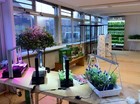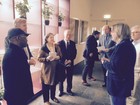Nieuwsberichten
Hoog Bezoek GreenNest Gallery
Hoog bezoek GreenNest Gallery Amsterdam
Drie zwarte BMW's zoefden op de middag van Goede vrijdag door Nederland. Het bestuur van AGRA (Alliance for a Green Revolution in Africa) met de directie van de Bill & Melinda Gates Foundation, trustees van de Rockefeller Foundation en ECONET oprichter Strive Masiyiwa kwamen op uitnodiging van prof. Rudy Rabbinge naar Nederland.
SIGN had Rob Baan en Ted Duijvestijn bereid gevonden hun innovatieve bedrijven open te stellen voor dit bezoek. Ze werden verwelkomd door Loek Hermans en Jan Willem Breukink van Topsector T&U. Rob hield een enthousiast pleidooi voor gezonde voeding en toonde welke positieve effecten de medische wetenschap langzamerhand ontdekt. Bij Ted waren LEDs te zien die het vitamine C gehalte kunnen verhogen in de tomaten en natuurlijk de speciale kas met dubbel glas. Het bezoek werd afgesloten met een ‘preview’ bezoek aan de Amsterdamse Greennest Gallery van SIGN. In de GreenNest Gallery zijn tal van tuinbouw innovaties te zien zijn. GreenNest Gallery Amsterdam gaat begin mei open voor bezoekers.
GreenNest Gallery

Hoog Bezoek

Voor AGRA spiegelde we een droom over het voedselsysteem in Lagos in 2030:
Dreaming of Lagos, 2030
The city has hundreds of decentralized sanitation units. The processed water is treated to remove contaminants like hormones and medicines; nitrogen and phosphate are recovered by plants. Stacked food production systems close the loops of nutrients and CO2. Exhaust air from buildings is being refreshed by plants in production facilities: they clean the air from fine dust and volatile components and thus contribute to healthy environments.
More than 10% of the population is involved in local food production and closing nutrient loops. Local waste streams, ranging from paper to cacao bean shells and spent brewers grain, are collected and upcycled by fungi like the Almond mushroom. The thus produced feed contains many beneficial substances like beta glucans, which improve the immune system of chicken. The manure of the chicken and the CO2 is subsequently used for a range of fruits and leafy greens. New technologies provide sterilization at low cost with solar energy. In this way, highly valued mushrooms and mushroom seed (spawn) can be produced with sustainable energy. The spent substrate is used to feed insects, which can either be eaten directly or serve as feed for fish. Solar energy also powers bacteria to absorb nitrogen from the air; the bacteria are used as a source of protein or fertiliser.
The different food production modules are stackable and can be connected. The acclimatised air for mushrooms has been enriched with CO2, which is subsequently used by plants in a greenhouse on top of the modules. In this way, highly productive food systems contribute to the cities of tomorrow. Only staple food like rice and corn has to be brought into the city. There, they can partly be transformed into more healthy sources of fibres and proteins by mushroom mycelium with a low glycemic index and immune stimulating properties.

 Dewi Hartkamp
Dewi Hartkamp

 Arjan
Arjan  RSS Feeds
RSS Feeds